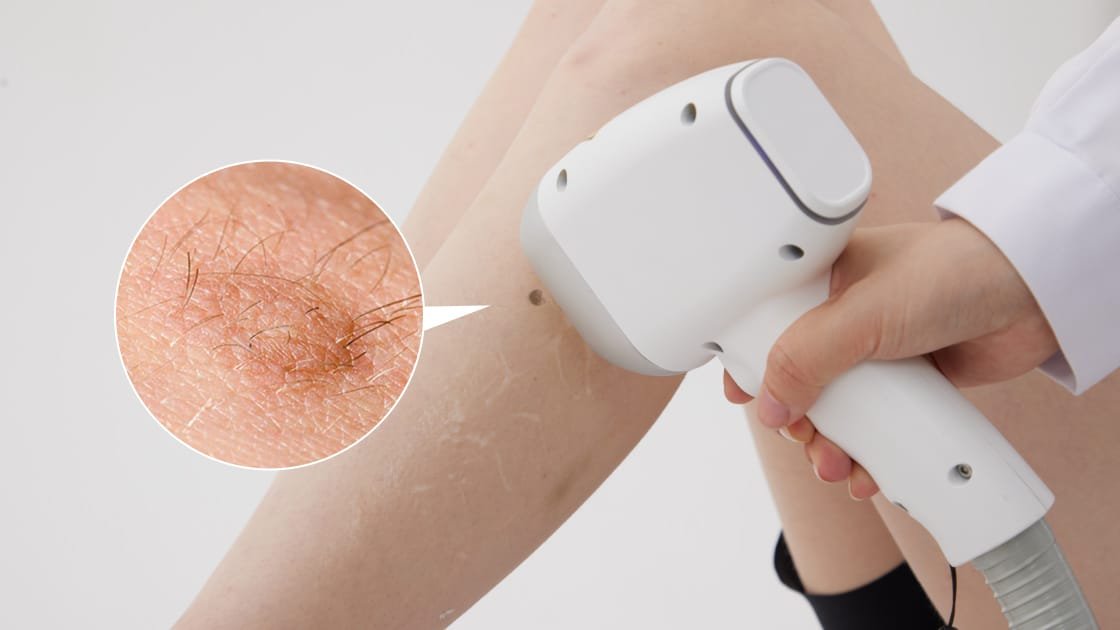Introduction: A Hairy Question Around Moles
Laser hair removal is one of the most sought-after methods for achieving smooth, hair-free skin. However, when it comes to removing hair near moles, many people have concerns. Is laser hair removal safe over moles? This question arises because moles contain concentrated pigment, which is similar to the pigment in hair follicles. So, how does this affect the safety and effectiveness of laser hair removal? Let’s explore the answers and discuss solutions to safely navigate hair removal in these sensitive areas.
Understanding Moles and Laser Hair Removal
Moles are clusters of pigmented cells, and they vary in size, shape, and color. Laser hair removal works by targeting the pigment in hair follicles with light energy, which is absorbed by the pigment, disabling the follicle and preventing hair growth. But what happens when this same light energy interacts with the pigment in a mole? While it may seem risky, laser technology has advanced to minimize these concerns.
Laser Technology: Targeting Hair Without Harming Moles
You can safely use laser hair removal near moles by understanding the proper techniques. Modern laser devices, especially those with advanced features like adjustable settings, target the pigment in hair follicles without harming the surrounding skin, including moles. These upgraded technologies allow professionals to control the intensity and focus of the laser, reducing the chance of affecting the mole itself.
Most professional clinics now use specialized lasers that avoid direct interaction with moles while still effectively treating surrounding hair. The key to success is choosing the right laser type and working with an experienced practitioner who can adjust settings to avoid complications.
Potential Risks of Laser Hair Removal Over Moles
Even with technological advancements, there are potential risks when applying laser hair removal machine directly to moles. These include:
- Pigmentation Changes: The mole might experience a temporary darkening or lightening of color due to the laser’s heat.
- Scarring: In rare cases, if the mole absorbs too much energy from the laser, it could cause scarring.
- Impairing Mole Evaluation: The laser could alter the appearance of a mole, making it harder to detect any abnormal changes in the future. This is why it’s always recommended to consult with a dermatologist beforehand.
These risks can be mitigated by working with professionals who understand how to safely navigate hair removal near moles, minimizing exposure to them while still targeting unwanted hair.
Safe Laser Hair Removal Options for Moles
While traditional methods like shaving, tweezing, or waxing are safe for removing hair around moles, they come with their own set of downsides. They can irritate sensitive skin, cause ingrown hairs, or require frequent maintenance. However, modern laser hair removal offers a better solution that doesn’t compromise safety or effectiveness.
When considering laser hair removal around moles, experts recommend the following precautions:
- Consult with a Dermatologist or Specialist: Before beginning treatment, consult with a qualified dermatologist or laser technician to assess the moles and determine the safest approach.
- Use Protective Measures: In many cases, the area surrounding the mole can be treated while the mole itself is covered or protected to avoid laser exposure.
- Choose the Right Laser: Modern lasers with adjustable settings are the best option, as they can target hair without harming nearby moles or skin.
How to Safely Remove Hair Near Moles with Laser
For those seeking laser hair removal near or around moles, a few steps can ensure a safe and effective procedure:
- Customized Treatment Plans: A professional will customize the treatment, adjusting the laser settings for optimal safety, especially around moles.
- Use of a Protective Shield: In some cases, a physical shield or a technique like spot treatment can be used to cover the mole, ensuring it isn’t affected by the laser.
- Post-Treatment Care: After the procedure, it’s important to follow aftercare instructions to keep the skin around the mole healthy and avoid irritation or complications.
What Happens if Laser is Applied Over Moles?
If the laser is accidentally applied directly over a mole, it may cause minor effects such as redness or temporary pigmentation changes. However, with modern technology and professional expertise, these occurrences are rare and manageable. If you notice any changes in the mole post-treatment, it’s crucial to consult a dermatologist promptly.
Conclusion: Making Informed Choices for Hair Removal
Laser hair removal can be safe around moles with proper precautions. Expertise, technology, and planning ensure safety. It offers a long-lasting solution for hair removal near moles. Consulting professionals helps you achieve smooth, hair-free skin without compromising skin health.








